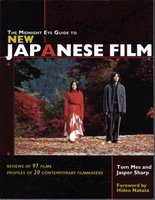 Tom Mes’ and Jasper Sharp’s splendid book, The Midnight Eye Guide to New Japanese Film, is a much needed and worthwhile contribution to the ever-growing list of review guides and in-depth studies pertaining to contemporary Asian films. Mes and Sharp are longtime aficionados of Asian films, especially Japanese productions, and are co-editors of the highly informative and useful web site MidnightEye.com, which focuses on the good, the bad, and the ugly of contemporary Japanese cinema.
Tom Mes’ and Jasper Sharp’s splendid book, The Midnight Eye Guide to New Japanese Film, is a much needed and worthwhile contribution to the ever-growing list of review guides and in-depth studies pertaining to contemporary Asian films. Mes and Sharp are longtime aficionados of Asian films, especially Japanese productions, and are co-editors of the highly informative and useful web site MidnightEye.com, which focuses on the good, the bad, and the ugly of contemporary Japanese cinema.But if you’re worried that the book is simply a hardcopy version of the web site’s free content, you can rest assure that the online version of Midnight Eye is only a springboard for what’s contained in the book version. As stated in the book’s introduction, the authors’ intentions were to write a book centering on the leading Japanese filmmakers of the day, explore their signature work more closely, and try to put into historical context films that have been largely ignored by the West. An ambitious task to say the least, but it succeeds on nearly every level. The only real complaint is that plenty of the films discussed are simply not available outside of Japan, and if you are able to acquire a non-English subtitled Japanese DVD or videotape from a retailer located there or Europe, it’s going to cost you, my friend—big time. But that’s hardly the authors’ fault, especially considering that with the advent of more and more people owning all-region DVD players and the proliferation of online web sites catering to the rich tastes of worldly cineastes, the benefits of a specialized guide such as this clearly outweigh the frustrating drawbacks.
The book profiles many of the international film festival heavyweights of Japanese film, such as Seijun Suzuki (Kanto Wanderer, Tokyo Drifter, Branded to Kill), Kinji Fukasaku (Black Lizard, Battles Without Honor and Humanity, Battle Royale), Shohei Imamura (Eijanaika, The Eel), Kiyoshi Kurosawa (Cure, Charisma, Bright Future), Isao Takahata and Hayao Miyazaki of Studio Ghibli fame (Grave of the Fireflies and Porco Rosso respectively), Shinya Tsukamoto (Tetsuo: The Iron Man, Tokyo Fist), Takeshi Kitano (Violent Cop, Sonatine, Hana-Bi), Takashi Miike (Bird People in China, Audition, Ichi the Killer), Hirokazu Kore-eda (After Life), Shinji Aoyama (Eureka), and Hideo Nakata (Ringu, Dark Water). But more importantly, Mes and Sharp devote considerable space to lesser-known (at least in the West) though no less interesting figures like Sogo Ishii (Crazy Thunder Road, August in the Water), Masato Harada (Kamikaze Taxi, Bounce KoGals), Kaizo Hayashi (To Sleep So As to Dream, The Most Terrible Time in My Life), Ryosuke Hashiguchi (Hush!), and Sabu (Dangan Runner, The Blessing Bell), among others.
The final third of the book is devoted to single films, whether from internationally known directors or not, which have made an impact on the film scene or are just too good or unusual to pass up. Critically-lauded and popular art house hits such as Tampopo, The Mystery of Rampo, Gohatto, and Shall We Dance? are featured, as well as more outré fare such as the transgressive Organ, the anime thriller Perfect Blue, the kaiju eiga standby Gamera 3: Revenge of Iris, the surreal horror film Uzumaki, and the all-CGI powered Final Fantasy: The Spirits Within. Even in such a specialized book such as this, there’s bound to be something for everyone.
A bibliography of “recommended reading” and a much needed index of titles and personalities are also included. Unfortunately, a no-interest, no-limit credit card is not.

No comments:
Post a Comment